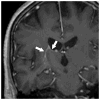Central Nervous System and Head and Neck Histiocytoses: A Comprehensive Review on the Spectrum of Imaging Findings
- PMID: 30417172
- PMCID: PMC6221469
- DOI: 10.3174/ng.2160150
Central Nervous System and Head and Neck Histiocytoses: A Comprehensive Review on the Spectrum of Imaging Findings
Abstract
The histiocytoses are a rare group of varied but related disorders characterized by abnormal tissue proliferation of macrophages and dendritic cells within tissues. The purpose of this article was to review the imaging findings in patients presenting with CNS and with head and neck manifestations of these disorders. Histiocytoses include but are not limited to Rosai-Dorfman disease, Erdheim Chester disease, Langerhans cell histiocytosis, histiocytic sarcoma, and juvenile xanthogranuloma. A review of the literature was performed to determine the sites of disease involvement. This article includes the demographics, histopathologic criteria for diagnosis, and imaging features of these histiocytoses, and describes the manifestations in locations known to harbor disease: intraaxial and extra-axial intracranial regions, the calvaria, skull base, hypothalamopituitary axis, orbits, paranasal sinuses, spine, and the head and neck region. Histiocytoses have variable imaging appearances in the CNS and in the head and neck region, and radiologists should be aware of the spectrum of findings to avoid mistaking them for other disease processes.
Learning objective: To understand the general pathophysiology, clinical presentation, and typical imaging characteristics of the most common histiocytoses; comprehend the morphologic and immunohistochemical characteristics of these histiocytoses and the hallmark findings on pathology; and be able to differentiate between these disorders based on their most common presentations.
Figures
















References
Grants and funding
LinkOut - more resources
Full Text Sources
